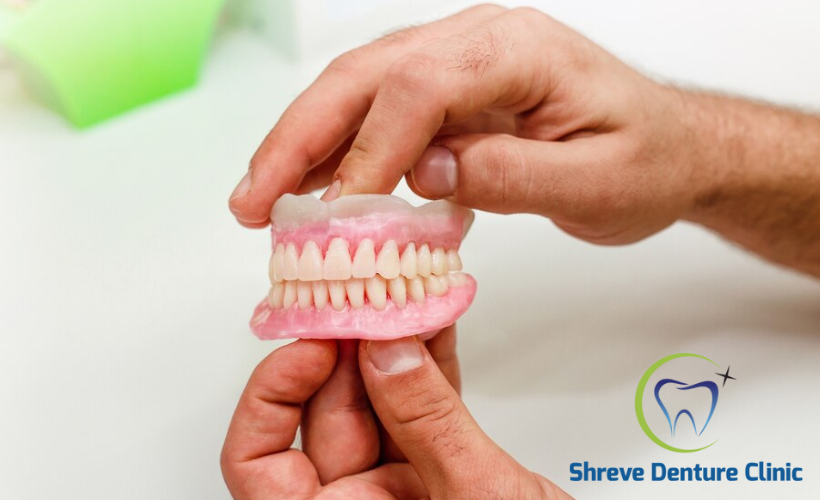As a denture wearer, there will be times when you need some type of reline to add new material to the surfaces of your replacement teeth. This will improve contact between the hard and soft tissues in your mouth.
If you notice ill-fitting dentures, you want to create stability and improve your chewing and suction ability. When used correctly, soft liners can increase the lifespan of your false teeth for an extended time period.
There are two common soft material options for relines: dimethyl siloxane (a silicone-based product) and polyethyl methacrylate (PEMA).

Soft denture relines are ideal if you have any of these issues:
- A sore spot that recurs frequently
- Tender gums
- A resorbed ridge from bone loss
Any of the conditions listed above can make it uncomfortable to wear dentures and could impact your oral health. Generally, the softer reline materials offer forgiving properties to cushion the blow of movement, allowing you to chew easily with less irritation.
Those with palate papillary hyperplasia and loose tissue may also find soft relines beneficial and can have well-fitting dentures once more.
How Long Will the Soft Relines Last?
The average lifespan for lab-processed soft liners is about one or two years. Though they use a durable material, replacement is often necessary, depending on your habits and how you care for your dentures.
Most dental offices offer temporary relines, which can work in a pinch. Plus, you can enjoy this process whether you have complete or partial dentures.
In most cases, silicone-based materials retain their resiliency much longer than PEMA products.
How to Clean Dentures Featuring Soft Relines
It’s important to clean your replacement teeth correctly, especially if you get normal or temporary relines. Here are the steps to take:
- Rinse your reline under cool water.
- Gently clean the reline with a denture brush.
- Try not to use effervescent denture cleansers to clean your soft reline. These products will accelerate the hardening process, causing brittleness and breakage that much sooner.
Steps to the Perfect Reline
If you have ill-fitting dentures, it’s likely time for a reline. Check with your professional denturist to determine if this is the right solution for you. Here are the steps the professional will take:
- Examine your bite, lip position, and midline to determine denture fit.
- Remove deep undercuts that might prevent your dentures from separating from the model.
- Adjust the borders that impinge on the soft tissues.
- Work with one denture base at a time, though use the opposing one to ensure proper occlusion.
- Roughen the tissue and border side of the denture with acrylic burs.
- Create tissue stops with a polyvinyl siloxane or modelling compound to maintain the best vertical occlusion dimension.
- Insert the denture into the patient’s mouth, ensuring that the pliable material is warm. Have the person bite down as hard as possible, allowing the polyvinyl siloxane to set. Remove it from the mouth.
- Adjust any tissue stops and remove undercuts. Reinsert the denture, checking for proper occlusion, stability, and position based on the person’s facial features and anatomy.
- If the denture borders are inaccurate or short, mould them in the mouth with rope wax or compound to extend them.
- Insert the denture back into the patient’s mouth, ensuring it’s resting on those tissue stops and is fully seated. It should be a passive fit when the patient is in occlusion.
- Dry off the denture.
- Apply appropriate adhesive to the borders and surfaces.
- Add PVS (polyvinyl siloxane) materials to coat the borders and inside of the denture, being careful not to overfill.
- Fully seat and align the denture until it’s resting on the tissue stops.
- Ask the patient to close their mouth fully.
- Check to ensure that the midline is correct.
- Ensure the lip position hasn’t changed after all that work compared to the initial exam.
- Whenever the bite or appearance isn’t exactly the same as for the initial exam, the dentist will let the material set fully, remove it, and begin again.
- Once the impression material is fully set, remove the denture and trim any excess product.
- Reinsert the denture.
- Repeat the entire process for the next denture.
Once the impressions have been taken, the dentist will send them to the laboratory, along with a prescription for a soft denture relining. This can be a lengthy process, so it’s wise to ensure this is the best solution.
Pricing for a Soft Reline
The price for dental relines can vary based on the dentist and laboratory used. Insurance companies often cover this service every two years. It’s important to check with yours to be sure this softer material can be inserted into the dentures and help with its fit.
Remember that denture repairs and relines often require you to be without your dentures because the lab must work on them. It’s wise to consider this option because they tend to last longer.
Why Choose Shreve Denture Clinic
Losing your natural teeth can be upsetting, and many people worry about getting stuck with ill-fitting dentures. However, they are designed to sit in place without moving too much.

If you’ve noticed that your dentures move around a lot, causing sore spots and other problems, it’s wise to visit your friendly dentist at Shreve Denture Clinic. We’re located in Leamington, Ontario, Canada and offer these services:
- Dental repairs
- Soft denture reline
- Complete & Partial dentures
- Immediate Dentures

Don’t hesitate to call 519-322-5900 to schedule an appointment and receive a free consultation. We want you to be happy with your dentures and smile more often.








